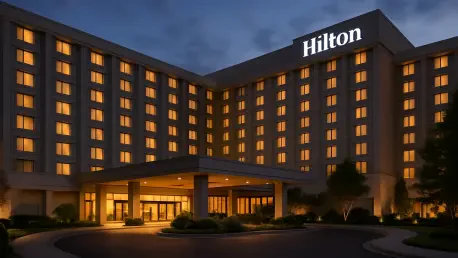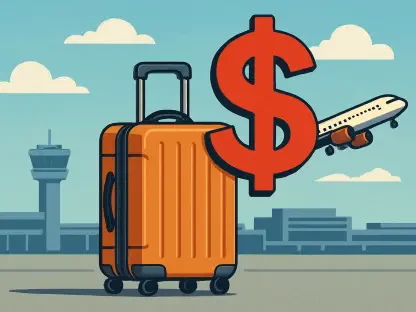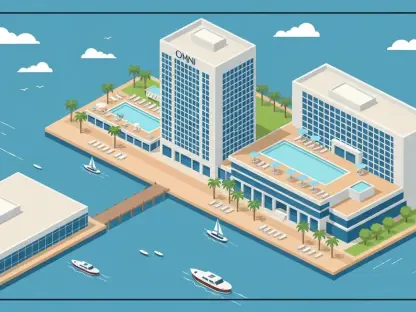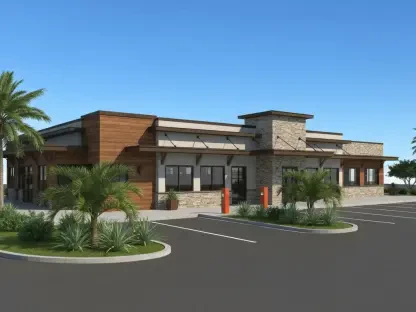In the fast-paced and ever-shifting world of hospitality, Hilton Worldwide has emerged as a compelling case study of resilience and calculated growth, particularly with its latest financial disclosures for the third quarter of 2025. Amid a backdrop of economic fluctuations and changing travel patterns, the company has achieved a year-to-date increase in revenue per available room (RevPAR), propelled by a strategic focus on boosting average daily rate (ADR). Yet, a closer look reveals a more complex story, as the third quarter brought a slight downturn, reflecting broader industry challenges. This duality of progress and setbacks offers a unique lens through which to examine Hilton’s current standing and future potential.
The hospitality giant’s ability to navigate these mixed results underscores its adaptability in a sector often swayed by external forces. While year-to-date RevPAR grew by a modest 0.3% compared to 2024, the third quarter saw a decline of 1.1%, driven by factors such as lower occupancy and unfavorable event timing. These figures set the stage for a deeper exploration of how Hilton balances short-term obstacles with long-term ambitions, positioning itself as a leader in a competitive market.
Financial Performance and Challenges
Year-to-Date Growth and Quarterly Setbacks
Hilton’s financial performance in 2025 paints a picture of both achievement and adversity, reflecting the intricate dynamics of the hospitality landscape. Year-to-date, the company reported a RevPAR increase of 0.3% compared to the previous year, a result largely attributed to a deliberate emphasis on elevating ADR. This pricing strategy has allowed Hilton to maintain revenue momentum despite fluctuating demand. However, the third quarter presented a contrasting scenario, with RevPAR dipping by 1.1%. This decline was influenced by several external pressures, including reduced occupancy rates, the timing of holidays and events, and a noticeable softening in international inbound travel to the U.S. Additionally, factors such as declines in government-related travel and ongoing portfolio renovations further compounded the challenges. These quarterly results highlight the unpredictable nature of the market and the need for agile responses to maintain financial health.
Beyond the RevPAR metrics, Hilton’s core revenue streams demonstrate notable resilience, offering a counterbalance to the quarterly dip. Management and franchise fee revenues saw a healthy rise of 5.3% in the third quarter and 6.1% year-to-date, underscoring the strength of the company’s operational model. Financial stability is further evidenced by improvements in net income and adjusted EBITDA, with third-quarter figures reaching $421 million and $976 million, respectively. These numbers reflect gains over the prior year, suggesting that despite temporary setbacks in room revenue, the broader financial framework remains robust. This stability provides a foundation for Hilton to weather short-term turbulence while focusing on strategic growth initiatives. The contrast between quarterly challenges and sustained revenue growth illustrates a company capable of navigating adversity with a steady hand, prioritizing long-term value over fleeting disruptions.
Balancing External Pressures with Internal Strength
The hospitality sector’s susceptibility to external influences is evident in Hilton’s third-quarter performance, where factors beyond control played a significant role in shaping outcomes. Reduced government travel, often a steady demand driver, took a hit, while international visitor numbers to the U.S. softened, reflecting global economic or geopolitical shifts. Portfolio renovations, while necessary for maintaining quality, temporarily impacted occupancy rates, adding another layer of complexity to the RevPAR decline. These elements collectively underscore the broader industry reality: even major players like Hilton must contend with variables that defy prediction or mitigation. Understanding these external pressures is crucial to appreciating the context behind the numbers and the inherent volatility of the travel market in which the company operates.
Despite these challenges, Hilton’s internal financial metrics offer a reassuring perspective on its capacity to endure and adapt. The uptick in net income to $421 million for the third quarter, alongside an adjusted EBITDA of $976 million, signals that the company’s profitability remains intact even amid revenue dips. This financial fortitude is complemented by a year-to-date net income of $1.16 billion and adjusted EBITDA of $2.78 billion, both marking improvements over the previous year. Such figures suggest that while RevPAR fluctuations capture attention, the underlying business model is structured to absorb shocks. This internal strength positions Hilton to not only manage current headwinds but also to invest in areas that promise future returns, ensuring that temporary setbacks do not derail overarching goals.
Strategic Expansion and Brand Innovation
Record-Breaking Development Pipeline
Hilton’s commitment to growth through physical expansion stands as a defining feature of its strategy, evident in its ambitious development activities during the third quarter of 2025. The company opened 199 hotels, adding approximately 24,800 rooms to its portfolio, while achieving a net room addition of 23,200. This rapid pace of growth is epitomized by the milestone of reaching its 9,000th property with the opening of a significant resort in Texas. The development pipeline remains equally impressive, encompassing 3,648 hotels with over 515,400 rooms across 128 countries as of late September. Nearly half of these projects are under construction, with a substantial portion located outside the U.S., reflecting a deliberate push into diverse global markets. This expansive pipeline positions Hilton to capitalize on limited supply growth in the industry, meeting rising travel demand with a robust inventory of new properties.
Beyond sheer numbers, Hilton’s expansion strategy is marked by a focus on diversity across brand segments and geographies, enhancing its global footprint. Notable openings in the third quarter included luxury and lifestyle properties such as the first Conrad in Germany and the debut of Curio Collection in Thailand. Further, new signings and groundbreaking ceremonies in markets like the Philippines and Vietnam introduced brands ranging from upscale to luxury, with nearly 1,800 rooms approved in the latter alone. These moves not only broaden Hilton’s presence but also cater to varying customer preferences, from aspirational luxury seekers to midscale travelers. By strategically placing properties in emerging and established markets alike, Hilton ensures it remains competitive in a sector where location and brand perception are paramount, setting the stage for sustained growth in an increasingly interconnected world.
Enhancing Market Presence Through Brand Diversity
Hilton’s approach to brand innovation goes hand in hand with its expansion, as the company seeks to address untapped market segments with tailored offerings. The launch of the Outset Collection targets the upper-midscale to upscale segment, with over 60 hotels already in development and potential for more than 500 properties in North America. This initiative focuses on a market often dominated by unbranded or independent hotels, offering a branded alternative that promises consistency and quality. Such strategic brand introductions demonstrate Hilton’s intent to capture diverse customer bases, ensuring relevance across different price points and travel motivations. This diversification is a calculated effort to strengthen market share in regions with high growth potential.
Additionally, Hilton’s foray into luxury and lifestyle branding, while not the primary driver of financial performance, plays a critical role in shaping brand perception. Partnerships, such as the one with Small Luxury Hotels of the World, have added 600 new locations to its network, creating a halo effect that elevates the entire portfolio’s appeal. These luxury offerings cater to aspirational travelers, enhancing Hilton’s image as a premier hospitality provider. Though the direct EBITDA contribution from luxury brands may be limited, their indirect impact on customer loyalty and brand equity is significant. By balancing high-end prestige with broad market accessibility through various brand tiers, Hilton crafts a comprehensive portfolio that appeals to a wide spectrum of travelers, reinforcing its competitive edge in a crowded industry.
Technology and Owner Support Initiatives
Leveraging Tech for Future Growth
At the forefront of Hilton’s strategy lies a strong emphasis on technological innovation, which is reshaping how the company operates and competes in the hospitality arena. With 90% of its enterprise solutions now hosted in the cloud—a substantial leap from just 20% a few years ago—Hilton is well-positioned to harness cutting-edge tools like artificial intelligence (AI). This shift enables the company to drive operational efficiencies, personalize guest experiences, and differentiate itself in a market where technology increasingly defines success. The focus on cloud-based systems facilitates real-time data analysis and scalability, allowing for quicker adaptation to customer needs and market trends. As AI continues to evolve, Hilton’s investment in such platforms promises to enhance everything from booking processes to property management, setting a benchmark for industry innovation.
Complementing its tech advancements, Hilton is also prioritizing stakeholder relationships through strategic owner support programs. A recently introduced initiative offers system-fee reductions to hotel owners, tied to specific quality scores for their properties. This program aims to share the efficiencies gained through scale and technology, ensuring that owners benefit while maintaining a high standard of guest experience. By aligning financial incentives with quality outcomes, Hilton fosters a collaborative environment where both the company and its partners thrive. This dual focus on technology and owner engagement underscores a broader vision: to build a sustainable ecosystem where innovation drives value for all involved, positioning Hilton as a forward-thinking leader in hospitality amidst rapid digital transformation.
Building Sustainable Partnerships
Hilton’s technological strides are not just about internal gains; they also pave the way for stronger partnerships that benefit the broader network of stakeholders. The cloud-based infrastructure and AI capabilities allow for seamless integration with third-party systems, enabling owners and operators to access sophisticated tools without significant independent investment. This democratization of technology ensures that even smaller properties within the portfolio can deliver consistent, high-quality experiences that align with brand standards. Such accessibility strengthens the bond between Hilton and its franchisees, creating a unified front in a competitive market. Moreover, these advancements help in predictive maintenance and resource allocation, reducing operational hiccups that could affect guest satisfaction or profitability.
Equally important is how Hilton’s owner support initiatives foster long-term loyalty among its partners, a critical factor in maintaining a cohesive global network. The fee reduction program, linked to quality metrics, incentivizes owners to prioritize guest experience, aligning their goals with Hilton’s overarching mission. This approach not only mitigates financial strain on owners during challenging periods but also ensures that properties uphold the standards that customers expect from the brand. By investing in these relationships, Hilton builds a foundation of trust and mutual benefit, essential for navigating industry uncertainties. The combination of tech-driven solutions and supportive policies reflects a holistic strategy to sustain growth, ensuring that both the company and its partners are equipped to face future challenges with confidence.
Outlook and Industry Trends
Cautious Optimism for the Future
Looking toward the horizon, Hilton’s leadership, spearheaded by CEO Christopher Nassetta, projects a sense of cautious optimism regarding the company’s trajectory and the broader hospitality landscape. RevPAR growth for 2025 is expected to range from flat to a modest 1%, with net income projected between $1.6 billion and $1.62 billion, and adjusted EBITDA anticipated to fall between $3.68 billion and $3.71 billion. For the fourth quarter specifically, RevPAR is forecasted to rise by about 1%, with net income expected in the range of $441 million to $462 million. These projections reflect a pragmatic approach, acknowledging current market softness while anticipating gradual improvement. Nassetta’s confidence is bolstered by expectations of favorable economic conditions, including lower interest rates and a more supportive regulatory environment, which could stimulate travel demand in the coming quarters.
Beyond immediate forecasts, the outlook for Hilton extends into a promising future, with stronger RevPAR growth anticipated for 2026 and 2027. This optimism is grounded in several industry trends, such as limited supply growth paired with rising global travel demand, positioning Hilton to capture a larger market share through its extensive pipeline. Additionally, federal legislation like the CHIPS and Science Act, with significant unspent funds, is expected to spur infrastructure and hotel development, creating new opportunities for expansion. Nassetta’s vision highlights a trajectory where economic tailwinds and strategic positioning converge, suggesting that Hilton is not merely reacting to market shifts but actively shaping its path forward. This forward-looking stance offers a glimpse into a hospitality sector poised for recovery and growth, with Hilton at the forefront.
Navigating Economic and Legislative Tailwinds
The broader economic environment plays a pivotal role in shaping Hilton’s future prospects, with several factors aligning to create a conducive setting for growth. Lower interest rates, often a catalyst for increased consumer spending and business investment, are expected to encourage more travel and hotel development over the next few years. A stable regulatory framework and clarity in tax policies further enhance this outlook, reducing uncertainty for hospitality companies planning long-term projects. These economic conditions provide a supportive backdrop for Hilton to execute its ambitious expansion plans, ensuring that capital investments in new properties and renovations yield optimal returns. The interplay of these elements suggests an industry on the cusp of a rebound, where strategic players like Hilton can thrive by leveraging macroeconomic trends.
Legislative support also emerges as a significant driver, with policies aimed at stimulating economic activity expected to benefit the hospitality sector directly. Initiatives such as the CHIPS and Science Act are anticipated to unlock funding for infrastructure projects, many of which will necessitate nearby accommodations, thus driving demand for hotel rooms. Hilton, with its robust development pipeline and diverse brand portfolio, stands ready to meet this demand, particularly in regions targeted for growth under such legislation. This synergy between policy and industry needs underscores a unique opportunity for the company to align its expansion with national priorities, enhancing both profitability and societal impact. As these tailwinds gather strength, Hilton’s proactive approach to capitalizing on them positions it as a leader ready to navigate the evolving landscape with agility and foresight.









